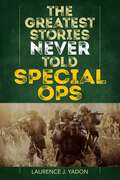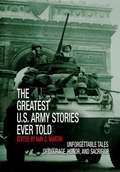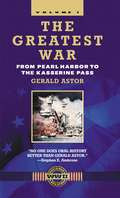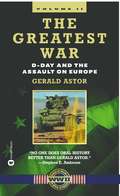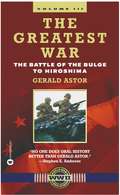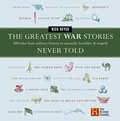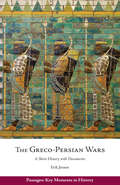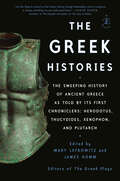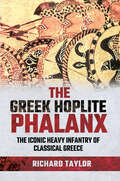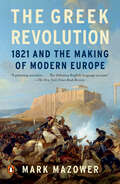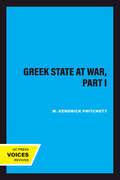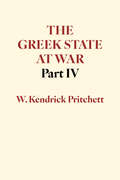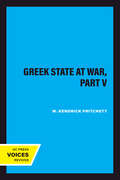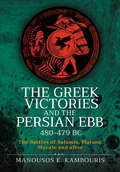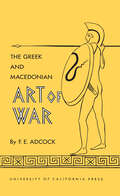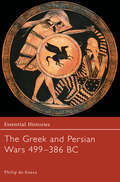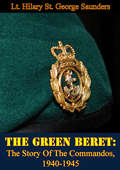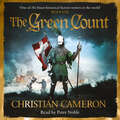- Table View
- List View
The Greatest Stories Never Told: Special Ops
by Laurence J. YadonIn The Greatest Stories Never Told: Special Ops, attorney and author Larry Yadon has written some of the greatest tales about special forces and operations – not twice- or thrice-told tales, but the ones you haven&’t heard before. It is an unforgettable collection, and includes stories of legendary operations from the late 18th century, when special forces emerged, through present-day Afghanistan and Iraq.
The Greatest Story Ever Sold: The Decline and Fall of Truth From 9/11 to Katrina
by Frank RichA step-by-step account of how skillfully the White House has built its house of cards, to consolidate its power at any cost.
The Greatest U.S. Army Stories Ever Told: Unforgettable Stories Of Courage, Honor, And Sacrifice
by Iain C. MartinEach story recounts the sights, sounds, and significance of such hallowed battlefields as Yorktown, Shiloh, and the Argonne. Watch row after row of redcoats attack during the Battle of Monmouth with eyewitness Joseph Plumb Martin. Ride a rickety boat with Washington in his famous night crossing over the Potomac.
The Greatest War - Volume I: From Pearl Harbor to the Kasserine Pass
by Gerald AstorWritten by award-winning journalist, acclaimed historian, and World War II veteran Gerald Astor, THE GREATEST WAR is an American combat history of World War II told largely in the words of the soldiers, sailors, airmen, and marines who fought--and ultimately emerged victorious from--this battle. In this third volume, Astor highlights the exploits of General MacArthur in the Philippines and General Patton in Germany and takes the reader from the Battle of the Bulge to the bombing of Hiroshima, and up through the end of the war. It is a gripping narrative of unparalleled courage, honor, and glory that is sure to become a military classic.
The Greatest War - Volume II: D-Day and the Assault on Europe
by Gerald AstorTold by soldiers, sailors, airmen, and marines, this series is an oral history of World War II from those who were there. This second volume examines the storming of Omaha Beach on D-Day, and the advance of allied forces across Europe to the liberation of Paris.
The Greatest War - Volume III: The Battle of the Bulge to Hiroshima
by Gerald AstorAn history of American combat in World War II through the words of the soldiers, sailors, airmen, and marines who were there.
The Greatest War Stories Never Told
by Rick BeyerSearch the annals of military history and you will discover no end of quirky characters and surprising true stories: The topless dancer who saved the Byzantine Empire. The World War I battle that was halted so a soccer game could be played. The scientist who invented a pigeon-guided missile in 1943. And don't forget the elderly pig whose death triggered an international crisis between the United States and Great Britain. This is the kind of history you'll find in The Greatest War Stories Never Told. One hundred fascinating stories drawn from two thousand years of military history, accompanied by a wealth of photographs, maps, drawings, and documents that help bring each story to life. Little-known tales told with a one-two punch of history and humor that will make you shake your head in disbelief -- but they're all true! Did You Know That: One military unit served on both sides during the Civil War. The War of Jenkins's Ear was actually fought over a sea captain's ear. Daniel Boone was once tried for treason. A siege on Poland in 1519 gave birth to the marriage of bread and butter Discover how war can be a catalyst for change; an engine for innovation; and an arena for valor, deceit, intrigue, ambition, revenge, audacity, folly, and even silliness. Want to know how the mafia helped the United States win World War II, when the word bazooka was coined, or how Silly Putty was invented? Read on!
The Greatest of All Leathernecks: John Archer Lejeune and the Making of the Modern Marine Corps
by Joseph Arthur SimonJoseph Arthur Simon’s The Greatest of All Leathernecks is the first comprehensive biography of John Archer Lejeune (1867–1942), a Louisiana native and the most innovative and influential leader of the United States Marine Corps in the twentieth century. As commandant of the Marine Corps from 1920 to 1929, Lejeune reorganized, revitalized, and modernized the force by developing its new and permanent mission of amphibious assault. Before that transformation, the corps was a constabulary infantry force used mainly to protect American business interests in the Caribbean, a mission that did not place it as a significant contributor to the United States defense establishment. The son of a plantation owner from Pointe Coupee Parish, Lejeune enrolled at Louisiana State University in 1881, aged fourteen. Three years later, he entered the U.S. Naval Academy, afterward serving for two years at sea as a midshipman. In 1890, he transferred to the Marines, where he ascended quickly in rank. During the Spanish-American War, Lejeune commanded and landed Marines at San Juan, Puerto Rico, to rescue American sympathizers who had been attacked by Spanish troops. A few years later, he arrived with a battalion of Marines at the Isthmus of Panama—part of Colombia at the time—securing it for Panama and making possible the construction of the Panama Canal by the United States. He went on to lead Marine expeditions to Cuba and Veracruz, Mexico. During World War I, Lejeune was promoted to major general and given command of an entire U.S. Army division. After the war, Lejeune became commandant of the Marine Corps, a role he used to develop its new mission of amphibious assault, transforming the corps from an ancillary component of the U.S. military into a vibrant and essential branch. He also created the Marine Corps Reserve, oversaw the corps’s initial use of aviation, and founded the Marine Corps Schools, the intellectual planning center of the corps that currently exists as the Marine Corps University. As Simon masterfully illustrates, the mission and value of the corps today spring largely from the efforts and vision of Lejeune.
The Greco-Persian Wars: A Short History with Documents (Passages: Key Moments in History)
by Erik JensenHackett's Passages: Key Moments in History series titles include original-source documents in accessible editions, intended for the student-user or general audience. This edition, The Greco-Persian Wars, taps our knowledge of the Persian Empire and its interactions with the Greek world. The sources examined were created in different times and places, for different purposes, and with different intended audiences. Using these sources effectively requires recognizing their distinct characteristics. A general introduction about the Greco-Persian wars is included to provide historical background and an overview of the information contained in the original-source documents. Also included are a glossary of terms, a chronology, insightful headnotes to each document, and an index.
The Greek Histories: The Sweeping History of Ancient Greece as Told by Its First Chroniclers: Herodotus, Thucydides, Xenophon, and Plutarch (Hackett Classics Ser.)
by James Romm Mary LefkowitzFrom the leading scholars behind The Greek Plays, a collection of the best translations of the foremost Greek historians, presenting a sweeping history of ancient Greece as recorded by its first chroniclers&“Just the thing to remind us that human history, though lamentably a work in progress, is always something we can understand better.&”—Sarah Ruden, translator of The Gospels and author of The Face of WaterThe historians of ancient Greece were pioneers of a new literary craft; their work stands among the world&’s most enduring and important legacies and forms the foundation of a major modern discipline. This highly readable edition includes new and newly revised translations of selections from Herodotus—often called the &“father of history&”—Thucydides, Xenophon, and Plutarch, the four greatest Greek innovators of historical narrative. Here the reader will find their most important, and most widely taught, passages collected in a single volume. The excerpts chart the landmark events of ancient Greece and provide a comprehensive account of the entire classical Greek age. From the start the Greek historians demonstrated how broad and varied historical writing could be and brought their craft beyond a mere chronicle of past events. This volume explores each author&’s interest in religion, leadership, character, and the lessons of war. How, for instance, should readers interpret Herodotus&’ inclusion of speeches and dialogues, dreams, and oracles as part of the &“factual&” record? What did Thucydides understand about human nature that (as he said) stays constant throughout time? How did Plutarch frame historical biography as a means of depicting the moral qualities of great men? Complete with introductions to the works of each historian, footnotes providing context and explaining obscurities, maps, and an appendix on the Greek conduct of war, this volume is an invaluable resource for students and passionate readers of history alike.
The Greek Hoplite Phalanx: The Iconic Heavy Infantry of the Classical Greek World
by Richard TaylorThe Greek hoplite and the phalanx formation in which he fought have been the subject of considerable academic debate over the past century. Dr Richard Taylor provides an overview of the current state of play in the hoplite debate in all its aspects, from fighting techniques to the social and economic background of the ‘hoplite revolution’, in a form that is accessible for the general reader and military history enthusiast. But the book goes further: offering a new perspective on the hoplite phalanx by putting it in the context of other military developments in the Mediterranean world in the middle of the first millennium BC. He argues that the Greek phalanx was different in degree but not in kind from other contemporary heavy infantry formations and that the hoplite debate, with its insistence on the unique nature of the hoplite phalanx, has obscured the similarities with other equivalent formations. The result is a fresh take on a perennially popular subject.
The Greek Revolution: 1821 and the Making of Modern Europe
by Mark MazowerFrom one of our leading historians, an important new history of the Greek War of Independence—the ultimate worldwide liberal cause célèbre of the age of Byron, Europe&’s first nationalist uprising, and the beginning of the downward spiral of the Ottoman Empire—published two hundred years after its outbreakAs Mark Mazower shows us in his enthralling and definitive new account, myths about the Greek War of Independence outpaced the facts from the very beginning, and for good reason. This was an unlikely cause, against long odds, a disorganized collection of Greek patriots up against what was still one of the most storied empires in the world, the Ottomans. The revolutionaries needed all the help they could get. And they got it as Europeans and Americans embraced the idea that the heirs to ancient Greece, the wellspring of Western civilization, were fighting for their freedom against the proverbial Eastern despot, the Turkish sultan. This was Christianity versus Islam, now given urgency by new ideas about the nation-state and democracy that were shaking up the old order. Lord Byron is only the most famous of the combatants who went to Greece to fight and die—along with many more who followed events passionately and supported the cause through art, music, and humanitarian aid. To many who did go, it was a rude awakening to find that the Greeks were a far cry from their illustrious forebears, and were often hard to tell apart from the Ottomans. Mazower does full justice to the realities on the ground as a revolutionary conspiracy triggered outright rebellion, and a fraying and distracted Ottoman leadership first missed the plot and then overreacted disastrously. He shows how and why ethnic cleansing commenced almost immediately on both sides. By the time the dust settled, Greece was free, and Europe was changed forever. It was a victory for a completely new kind of politics—international in its range and affiliations, popular in its origins, romantic in sentiment, and radical in its goals. It was here on the very edge of Europe that the first successful revolution took place in which a people claimed liberty for themselves and overthrew an entire empire to attain it, transforming diplomatic norms and the direction of European politics forever, and inaugurating a new world of nation-states, the world in which we still live.
The Greek State at War, Part I
by W. Kendrick PritchettThe volumes of The Greek State at War are an essential reference for the classical scholar. Professor Pritchett has systematically canvassed ancient texts and secondary literature for references to specific topics; each volume explores a unique aspect of Greek military practice.
The Greek State at War, Part IV
by W. Kendrick PritchettThe volumes of The Greek State at War are an essential reference for the classical scholar. Professor Pritchett has systematically canvassed ancient texts and secondary literature for references to specific topics; each volume explores a unique aspect of Greek military practice.The volumes of The Greek State at War are an essential reference for the classical scholar. Professor Pritchett has systematically canvassed ancient texts and secondary literature for references to specific topics; each volume explores a unique aspect of </DIV
The Greek State at War, Part V
by W. Kendrick PritchettThe volumes of The Greek State at War are an essential reference for the classical scholar. Professor Pritchett has systematically canvassed ancient texts and secondary literature for references to specific topics; each volume explores a unique aspect of Greek military practice. In Part V he takes up stone throwers, slingers, and booty.
The Greek Victories and the Persian Ebb 480–479 BC: The Battles of Salamis, Plataea, Mycale and after
by Manousos E. KambourisThe dramatic conclusion to this trilogy explains the reversal of fortunes and final defeat of Xerxes’ Persian invasion of Greece; not as unlikely as usually presupposed. The focus is on the successful repulse of the Persian massive armada at Salamis, a resounding naval victory with parallels to the English defeat of the Spanish Armada. Along with the backstage policies and cloak-and-dagger events, the analysis of hard data of naval and military realities and environment shows the reason for this outcome and more so of the closely fought double campaign of the following year that ended the Persian threat. The massive land victory at Plataea that ousted the empire form mainland Greece and crippled its armies, and the amphibious operation at Mycale that destroyed the remnants of the royal Grand Armada and shut the doors to further Persian incursions in Greece is examined in detail. Manousos Kambouris examines in depth the plans, potential, assets and liabilities of the two protagonists to explain command decisions and developments in the field. This is a fine finale to this fresh appraisal of these hugely significant events.
The Greek and Macedonian Art of War (Sather Classical Lectures #30)
by Frank E. AdcockThis informal history traces battle tactics and military strategy from the time of the city-states' phalanxes of spearmen to the far-reaching combined operations of specialized land and sea forces in the Hellenistic Age. The author first describes the attitude of the Greek city-state toward war, and shows the military conventions and strategies associated with it. He then recounts how the art of war gradually evolved into new forms through the contributions of such men as the great commander Epaminondas, Philip of Macedon, his son Alexander the Great, and others. He also discusses the independence of land and sea power, describes the first use of calvary, and tells of the ingenious Greek devices of siegecraft, including the "fifth column."
The Greek and Persian Wars 499-386 BC (Essential Histories #36)
by Philip de SouzaFirst published in 2004. Routledge is an imprint of Taylor & Francis, an informa company.
The Green Beret Survival Guide: Advice on Situational Awareness, Personal Safety, Recognizing Threats, and Avoiding Terror and Crime
by Brian M. MorrisToday's society is one in which we, as individuals, are constantly barraged by the threat of domestic terrorism. The ever-present fear for your safety and the safety of those we love can overwhelm you if you aren’t sure how to protect yourself. Luckily, distinguished combat veteran Brian M. Morris's Green Beret Survival Guide is here to help ease your fears. Using his firsthand knowledge from the field as a Green Beret, Morris concisely outlines the steps that are necessary towards increasing one’s personal safety. Over the course of several chapters, Morris describes the importance of situational awareness, meaning staying alert, being aware of your surroundings, and understanding the reality of threats that you may face in any given situation. An individual with good situational awareness never takes anything for granted and makes security a part of his or her daily routine. By being observant and practicing several different methods of observation, one can avoid falling prey to terrorist, thieves, and other criminals. Using situational awareness as the cornerstone of a personal safety plan, The Green Beret Survival Guide delivers expert advice on preparing you and your loved ones for the worst case scenario.
The Green Beret: The Story Of The Commandos, 1940-1945
by Lt. Hilary St. George Saunders Earl Mountbatten of Burma"I am not worried about the fighting. I know you're fairly bloody-minded. But I want to speak of discipline during the battle.""You must get ashore, if you have to swim, and I hope some of you will return as you'll be very useful for the next show."The words of a Commando officer to his men before they stormed the beaches of Sicily under heavy machine-gun fire sum up the swashbuckling, devil-may-care spirit of the toughest fighting men produced--the Commandos.For their raids and battles far behind enemy lines in France, North Africa, Sicily, Italy and Burma the men in the Green Beret have become a legend.This book shows how this legend was forged.
The Green Berets: The Amazing Story of the U. S. Army's Elite Special Forces Unit
by Robin Moore Thomas R. CsrnkoRobin Moore became one of the first true embedded journalists by training with and fighting alongside the Green Berets in Vietnam. Though fictionalized, his work is an eye-opening exposé of the horrors of the Vietnam War and the basis for the hit John Wayne movie of the same title. Taut, fast-paced, and interspersed with unforgettable accounts of combat, Moore's novel features an American major who goes "native" with Montagnard tribesmen, a courageous Vietnamese girl who poses as a rabid anti-American Communist to capture a murderous Viet Cong officer and the unforgettable acts of courage of soldiers in the field.
The Green Count (Chivalry #3)
by Christian CameronOne of the finest historical fiction writers in the world - Ben KaneAfter the bloody trials of Alexandria, Sir William Gold is readying for a pilgrimage to Jerusalem to ease the burden on his soul. He hopes, too, that the Holy City might allow his relationship with Emile, cousin of the Green Count of Savoy, to develop.But the Roman Emperor of Constantinople has been taken hostage by an unknown enemy, and the Green Count is vital to the rescue effort. It is up to Sir William to secure his support, but he soon finds that his past, and his relationship with Emile, might have repercussions he had not foreseen...Suddenly thrust onto the stage of international politics, Sir William finds himself tangled in a web of plots, intrigue and murder. He must hold true to his chivalric principles, and to his knights, if he is to save the Emperor and survive to tell the tale.
The Green Count (Chivalry #5)
by Christian CameronOne of the finest historical fiction writers in the world - Ben KaneAfter the bloody trials of Alexandria, Sir William Gold is readying for a pilgrimage to Jerusalem to ease the burden on his soul. He hopes, too, that the Holy City might allow his relationship with Emile, cousin of the Green Count of Savoy, to develop.But the Roman Emperor of Constantinople has been taken hostage by an unknown enemy, and the Green Count is vital to the rescue effort. It is up to Sir William to secure his support, but he soon finds that his past, and his relationship with Emile, might have repercussions he had not foreseen...Suddenly thrust onto the stage of international politics, Sir William finds himself tangled in a web of plots, intrigue and murder. He must hold true to his chivalric principles, and to his knights, if he is to save the Emperor and survive to tell the tale.
The Green Count (Chivalry Ser.)
by Christian CameronOne of the finest historical fiction writers in the world - Ben KaneAfter the bloody trials of Alexandria, Sir William Gold is readying for a pilgrimage to Jerusalem to ease the burden on his soul. He hopes, too, that the Holy City might allow his relationship with Emile, cousin of the Green Count of Savoy, to develop.But the Roman Emperor of Constantinople has been taken hostage by an unknown enemy, and the Green Count is vital to the rescue effort. It is up to Sir William to secure his support, but he soon finds that his past, and his relationship with Emile, might have repercussions he had not foreseen...Suddenly thrust onto the stage of international politics, Sir William finds himself tangled in a web of plots, intrigue and murder. He must hold true to his chivalric principles, and to his knights, if he is to save the Emperor and survive to tell the tale.
The Green Gauntlet (A Horseman Riding By #3)
by R. F. DelderfieldIn "The Green Gauntlet", we return to the seven families whose lives are rooted in the green acres of the great farming valley of Shallowford. The time is just at the outbreak of the Second World War, when the valiant pilots of the RAF are locked in combat with the Luftwaffe in the skies above Devon and England stands imperiled as never before by the dark shadow of Nazi invasion. The hero again is Paul Craddock -- older, wiser, but still fiercely dedicated to his land, to his children and grandchildren, to his tenants and to the vanishing way of life they represent.
